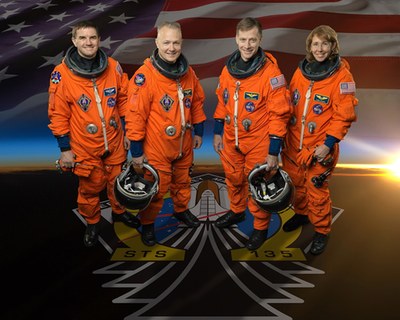The last shuttle crewby Anthony Young
|
| There is little doubt the landing of the shuttle Atlantis will be broadcast live and replayed many times around the world as debate continues about America’s next foray into human space flight. |
The crew of the last shuttle flight is, in fact, the crew for the rescue mission for STS-134, Endeavour. These rescue missions were conceived to retrieve astronauts from the International Space Station who could not return to Earth due to damage sustained to the shuttle during the boost phase or some other system failure preventing them from returning with that shuttle. The mission number for that rescue flight was STS-335, but with the successful mission of Endeavour to the International Space Station—and the Congressional funding of one last mission—STS-335 became STS-135.
One caveat of this mission it is that there is no Launch On Need shuttle as with previous flights. If the crew of STS-135 needed to return to Earth from the ISS in the event Atlantis cannot safely reenter the atmosphere, a mission will be mounted by the Russian partners and the crew brought back aboard one of their Soyuz capsules.
The crew and mission of STS-135
Commander of this last shuttle mission is Chris Ferguson. He first flew aboard STS-115 using the shuttle Atlantis in September 2006. He was also commander of STS-126 with the shuttle Endeavour launched in November 2008. Pilot for STS-135 is Col. Doug Hurley. He was also pilot for STS-127, his first shuttle flight. That mission lasted a near-record 16 days. Dr. Sandra Magnus will fly on the shuttle for the third time with STS-135. Previously, she was mission specialist on STS-112 launched in October 2002 and subsequently entered training for a long-duration assignment aboard the ISS. She was mission specialist on STS-126 and then spent the next four and a half months aboard the ISS. She returned to Earth with the crew of STS-119 on March 28, 2009. The last crew member of STS-135 is Rex Walheim. He was mission specialist aboard STS-110 aboard the shuttle Atlantis launched in April 2002. He flew aboard Atlantis again as mission specialist with STS-122 launched in February 2008.
| There will be a long hiatus between this last shuttle launch from KSC and the next American crew to be launched from American soil to low Earth orbit. |
The prime mission of STS-135 is to deliver the Multi-Purpose Logistics Module to the ISS. The rest of the shuttle cargo bay will be empty. Nevertheless, the mission is scheduled to last approximately 12 days. No doubt the emotions will be kept in check as the crew leaves the ISS with Atlantis and returns to Earth, hopefully to land at Kennedy Space Center, weather permitting. There is little doubt the landing of the shuttle Atlantis will be broadcast live and replayed many times around the world as debate continues about America’s next foray into human space flight.
And then what happens?
NASA astronaut crews will continue to train for missions to the ISS, but they will be training—as they already have been—to fly aboard Russian Soyuz spacecraft. There will be a long hiatus between this last shuttle launch from KSC and the next American crew to be launched from American soil to low Earth orbit. There was, of course, a significant span of time between the last Apollo mission, launched July 15, 1975, for the Apollo-Soyuz mission, and the first shuttle launch on April 12, 1981. So, America has been through a long, dry spell like this before.
America’s next launch vehicles for human spaceflight will embrace the more conventional separate rocket booster and crew capsule. The shuttle was, indeed, a unique spacecraft that will in all likelihood never be repeated. It was and remains an extraordinary human spacecraft that no other nation on Earth succeeded in duplicating and launching. The Soviets designed and built the practically line-for-line copy of the shuttle they called the Buran, which flew—unmanned—only once.
To speculate at this point as to the configuration and, in fact, the manufacturer of the next US manned launch vehicle is really a gamble. Armchair prognosticators ask why not use the Delta 4 Heavy, while others point to the successful launch of the SpaceX Falcon 9 rocket and its Dragon capsule as an obvious choice. Certainly, the Ares 1-X launch vehicle developed by NASA and successfully launched on a suborbital flight on October 28, 2009 did not lead to further development as that program, and the parent Constellation program was cancelled.
In short, it is too early still to speculate about the next likely configuration for a launch vehicle for America’s human space flight program. What Americans can do is reflect on the technological marvels of the Space Transportation System and its shuttles, their crews, and the glorious accomplishments they brought the United States in the 20th and the 21st centuries.
